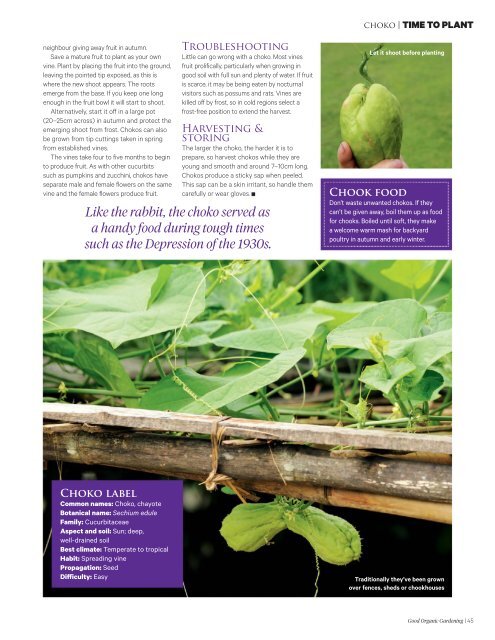5. Good Organic Gardening - September-October 2016 AvxHome.in
5. Good Organic Gardening - September-October 2016 AvxHome.in
5. Good Organic Gardening - September-October 2016 AvxHome.in
You also want an ePaper? Increase the reach of your titles
YUMPU automatically turns print PDFs into web optimized ePapers that Google loves.
choko | TIME TO PLANT<br />
neighbour giv<strong>in</strong>g away fruit <strong>in</strong> autumn.<br />
Save a mature fruit to plant as your own<br />
v<strong>in</strong>e. Plant by plac<strong>in</strong>g the fruit <strong>in</strong>to the ground,<br />
leav<strong>in</strong>g the po<strong>in</strong>ted tip exposed, as this is<br />
where the new shoot appears. The roots<br />
emerge from the base. If you keep one long<br />
enough <strong>in</strong> the fruit bowl it will start to shoot.<br />
Alternatively, start it off <strong>in</strong> a large pot<br />
(20–25cm across) <strong>in</strong> autumn and protect the<br />
emerg<strong>in</strong>g shoot from frost. Chokos can also<br />
be grown from tip cutt<strong>in</strong>gs taken <strong>in</strong> spr<strong>in</strong>g<br />
from established v<strong>in</strong>es.<br />
The v<strong>in</strong>es take four to five months to beg<strong>in</strong><br />
to produce fruit. As with other cucurbits<br />
such as pumpk<strong>in</strong>s and zucch<strong>in</strong>i, chokos have<br />
separate male and female flowers on the same<br />
v<strong>in</strong>e and the female flowers produce fruit.<br />
Troubleshoot<strong>in</strong>g<br />
Little can go wrong with a choko. Most v<strong>in</strong>es<br />
fruit prolifically, particularly when grow<strong>in</strong>g <strong>in</strong><br />
good soil with full sun and plenty of water. If fruit<br />
is scarce, it may be be<strong>in</strong>g eaten by nocturnal<br />
visitors such as possums and rats. V<strong>in</strong>es are<br />
killed off by frost, so <strong>in</strong> cold regions select a<br />
frost-free position to extend the harvest.<br />
Harvest<strong>in</strong>g &<br />
stor<strong>in</strong>g<br />
The larger the choko, the harder it is to<br />
prepare, so harvest chokos while they are<br />
young and smooth and around 7–10cm long.<br />
Chokos produce a sticky sap when peeled.<br />
This sap can be a sk<strong>in</strong> irritant, so handle them<br />
carefully or wear gloves.<br />
Like the rabbit, the choko served as<br />
a handy food dur<strong>in</strong>g tough times<br />
such as the Depression of the 1930s.<br />
Let it shoot before plant<strong>in</strong>g<br />
Chook food<br />
Don’t waste unwanted chokos. If they<br />
can’t be given away, boil them up as food<br />
for chooks. Boiled until soft, they make<br />
a welcome warm mash for backyard<br />
poultry <strong>in</strong> autumn and early w<strong>in</strong>ter.<br />
Choko label<br />
Common names: Choko, chayote<br />
Botanical name: Sechium edule<br />
Family: Cucurbitaceae<br />
Aspect and soil: Sun; deep,<br />
well-dra<strong>in</strong>ed soil<br />
Best climate: Temperate to tropical<br />
Habit: Spread<strong>in</strong>g v<strong>in</strong>e<br />
Propagation: Seed<br />
Difficulty: Easy<br />
Traditionally they’ve been grown<br />
over fences, sheds or chookhouses<br />
<strong>Good</strong> <strong>Organic</strong> <strong>Garden<strong>in</strong>g</strong> | 45

















